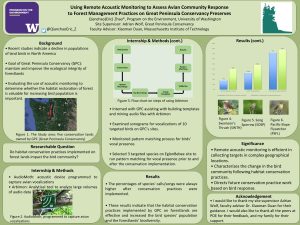USING REMOTE ACOUSTIC MONITORING TO ASSESS AVIAN COMMUNITY RESPONSE TO FOREST MANAGEMENT PRACTICES ON GREAT PENINSULA CONSERVANCY PRESERVES
As the populations of landbird species in North America have declined dramatically, it is appropriate to implement conservation practices to improve the avian biodiversity and health of the Great Peninsula Conservancy’s (GPC) forestlands. GPC is a land trust that owns and manages conservational lands in Washington State. The goal of GPC is to maintain or improve the ecological integrity of forestlands by increasing structural (horizontal and vertical) and species diversity. The aim of this study is to collect bird acoustic recordings and responses via remote acoustic monitoring (AudioMoth), along with use of Arbimon to analyze large amounts of acoustic data. The study of the distribution of birds on GPC’s sites serves as an indicator of the effectiveness of the conservation practices implemented by GPC. To accomplish this, I used the avian data analysis tool, Arbimon, to create templates for target species and validate each bird calls and songs. Then I generated results and conclusion based on Arbimon’s pattern matching function: the percentages of the target species’ calls or songs were always higher after conservation practices were implemented. Therefore, I conclude that the conservation practices implemented by GPC are effective in protecting and improving the avian biodiversity and health of forestlands in Washington state. This conclusion can guide in understanding of efficiency and usefulness of remote acoustic monitoring, which can lead to future environmental restoration actions on forestlands and raise our awareness of wildlife responses to ecological conservation practices.
